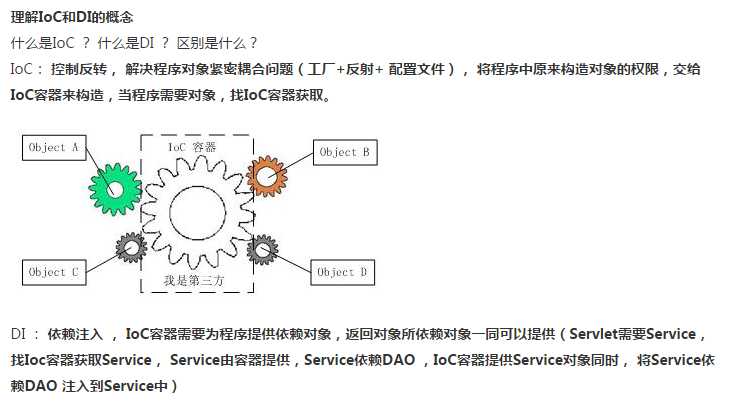标签:
Spring框架:
传统JavaEE解决企业级应用问题时的“重量级”架构体系,使它的开发效率,开发难度和实际的性能都令人失望。Spring是以一个
救世主的身份降临在广大的程序员面前。Spring致力于JavaEE应用的各种解决方案,而不是仅仅专注于某一层的方案也可以说Spring
是一个企业级应用开发的一站式选择。Spring贯穿表现层,业务层,持久层。然而,Spring并不是为了取代他们而出现而是以高度的
开放性与它们无缝整合。
Spring核心:
IOC控制反转(Inversion of Control )也被称为依赖注入(Dependency Injection ,DI)是面向对象编程中的一种设计理念,用来减低
程序代码之间的耦合度
AOP面向切面编程(Aspect Oriented Programming,AOP)是软件编程思想发展到一定阶段的产物是面向对象编程(Object Oriented Programming)
的有益补充。AOP一般适用于有横切逻辑的场合,如访问控制,事务管理,性能检测等。

IOC和AOP使用扩展
使用多种方式实现依赖注入:
第一步创建出Car类
package cn.happy.day01.entity; public class Car { private String color; @Override public String toString() { return "Car [color=" + color + "]"; } public String getColor() { return color; } public void setColor(String color) { this.color = color; } }
第二步创建出一个实体类Student
package cn.happy.day01.entity; public class Student { private String name; private int age; private Car myCar; public Student() { System.out.println("init student"); } @Override public String toString() { return "Student [name=" + name + ", age=" + age + ", myCar=" + myCar + "]"; } public Student(String name, int age, Car myCar) { System.out.println("i am has args constructor"); this.name = name; this.age = age; this.myCar = myCar; } public String getName() { return name; } public void setName(String name) { this.name = name; } public int getAge() { return age; } public void setAge(int age) { this.age = age; } public Car getMyCar() { return myCar; } public void setMyCar(Car myCar) { this.myCar = myCar; } }
接下来就就是编写applicationContext.xml配置
<?xml version="1.0" encoding="UTF-8"?> <beans xmlns="http://www.springframework.org/schema/beans" xmlns:xsi="http://www.w3.org/2001/XMLSchema-instance" xmlns:aop="http://www.springframework.org/schema/aop" xmlns:p="http://www.springframework.org/schema/p" xsi:schemaLocation=" http://www.springframework.org/schema/beans http://www.springframework.org/schema/beans/spring-beans.xsd http://www.springframework.org/schema/aop http://www.springframework.org/schema/aop/spring-aop.xsd "> <bean id="mmCar" class="cn.happy.day01.entity.Car"> <property name="color" value="green color"></property> </bean> <!-- <bean id="stu1" class="cn.happy.day01.entity.Student"> <property name="name" value="微冷的雨"></property> <property name="age" value="18"></property> <property name="myCar" ref="mmCar"></property> </bean> --> <!--01.构造器注入 --> <bean id="stu2" class="cn.happy.day01.entity.Student"> <constructor-arg index="0" value="微冷的雨"></constructor-arg> <constructor-arg index="1" value="18"></constructor-arg> <constructor-arg index="2" ref="mmCar"></constructor-arg> </bean> <!--02.p命名空间注入 --> <bean id="stu3" class="cn.happy.day01.entity.Student" p:name="国庆放假买手机" p:age="18" p:myCar-ref="mmCar"> </bean> <!--05.各种类型注入之 集合 之 List--> <bean id="list" class="cn.happy.day01.entity.CollectionBean"> <property name="list"> <list> <value>方言</value> <value>李小龙</value> </list> </property> </bean> <!--06.各种类型注入之 集合 之 Set--> <bean id="set" class="cn.happy.day01.entity.CollectionBean"> <property name="set"> <set> <value>方言</value> <value>李小龙</value> </set> </property> </bean> <!--07.各种类型注入之 集合 之 Map--> <bean id="map" class="cn.happy.day01.entity.CollectionBean"> <property name="map"> <map> <entry key="fy"> <value>方言</value> </entry> <entry key="lxl"> <value>李小龙</value> </entry> </map> </property> </bean> </beans>
关于上面注入集合的内容创建一个集合的类即可:
package cn.happy.day01.entity; import java.util.List; import java.util.Map; import java.util.Properties; import java.util.Set; /** * 集合Bean * @author Happy * */ public class CollectionBean { private List<String> list; private Set<String> set; private Map<String,String> map; private String [] empName;//数组 private Properties pp;//Properties的使用 public String[] getEmpName() { return empName; } public void setEmpName(String[] empName) { this.empName = empName; } public Properties getPp() { return pp; } public void setPp(Properties pp) { this.pp = pp; } public List<String> getList() { return list; } public void setList(List<String> list) { this.list = list; } public Set<String> getSet() { return set; } public void setSet(Set<String> set) { this.set = set; } public Map<String, String> getMap() { return map; } public void setMap(Map<String, String> map) { this.map = map; } }
最后我们编写测试类测试即可
package cn.happy.day01.test; import org.springframework.context.ApplicationContext; import org.springframework.context.support.ClassPathXmlApplicationContext; import cn.happy.day01.entity.CollectionBean; import cn.happy.day01.entity.Student; public class Spring_01Test { public static void main(String[] args) { testCollectionMap(); } /** * 1.1 spring容器创建的时候,会将所有配置的bean对象创建 */ /*@Test public void testOne(){ //容器一旦生成,bean都被加载到内存 ApplicationContext ctx=new ClassPathXmlApplicationContext("applicationContext.xml"); Student stu = (Student)ctx.getBean("stu1"); System.out.println(stu); Student stu = (Student)ctx.getBean("stu1"); Student stu2 = (Student)ctx.getBean("stu1"); System.out.println(stu); System.out.println(stu2); }*/ static void testCollectionMap(){ ApplicationContext ctx=new ClassPathXmlApplicationContext("applicationContext.xml"); CollectionBean bean=(CollectionBean)ctx.getBean("map"); System.out.println(bean.getMap()); } //every type injection of Collection Set static void testCollectionSet(){ ApplicationContext ctx=new ClassPathXmlApplicationContext("applicationContext.xml"); CollectionBean bean=(CollectionBean)ctx.getBean("set"); System.out.println(bean.getSet()); } //every type injection of Collection List static void testCollectionList(){ ApplicationContext ctx=new ClassPathXmlApplicationContext("applicationContext.xml"); CollectionBean bean=(CollectionBean)ctx.getBean("list"); System.out.println(bean.getList()); } //04.域属性的注入 static void testJavaBean(){ ApplicationContext ctx=new ClassPathXmlApplicationContext("applicationContext.xml"); Student stu=(Student)ctx.getBean("stu1"); System.out.println(stu); } //03.普通属性注入 static void testUseful(){ ApplicationContext ctx=new ClassPathXmlApplicationContext("applicationContext.xml"); } //02.P命名空间注入 static void testPInjection(){ ApplicationContext ctx=new ClassPathXmlApplicationContext("applicationContext.xml"); Student stu = (Student)ctx.getBean("stu3"); System.out.println(stu); } //01.1构造注入 static void testConstructorInjection2(){ ApplicationContext ctx=new ClassPathXmlApplicationContext("applicationContext.xml"); Student stu = (Student)ctx.getBean("stu2"); System.out.println(stu); } //01.构造注入 static void testConstructorInjection(){ ApplicationContext ctx=new ClassPathXmlApplicationContext("applicationContext.xml"); Student stu = (Student)ctx.getBean("stu2"); System.out.println(stu); } }
标签:
原文地址:http://www.cnblogs.com/System-out-println/p/5945091.html